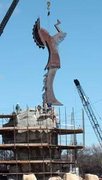The Stock Market Falls Again
Here it is Friday afternoon and the U.S. Stock Market is down some more after a 144 point plunge yesterday. The Fed of Philadelphia's activity index took a dive and new claims for unemployment jumped over a half million. That latter is one statistic economists do not want to see rise and it is one of the Conference-Board's leading indicators. Yesterday's plunge turned a nicely developing global rally into a global route.
Markets have been particularly spooked since the Commerce Department issued its GDP report a week a go. The economy grew at a 2.4 percent rate in the second quarter. This was seen as lack luster growth. However the deceleration was not due to a lack of demand but to an over appetite for imports. Real, domestic final demand grew at a 4 percent annual rate. More economic stimulus would further aggravate our current account balance.
Its Bureau of Economic Analysis revised the last two and a half years of national income accounts estimates showing, as I expected, that the recession was deeper and the recovery stronger than previously reported.
Good News From Germany
The global rally had been fueled by news that the Bundesbank had increased its forcast of German economic growth. Germany is the Eurozone's engine. Moreover the strength in the world economy is reflected in the new resource M&A boom according to Javier Blas and William MacNamara in the Financial Times. They report, "The rise of China and India has sparked a renewed surge in aggressive dealmaking in the resources sector, with more than $50bn in proposed takeovers this week alone wagering on continued strong commodities demand."
The American stock market is focused on the possibillity of a "double-dip recession." As I said yesterday, "I don't see a double-dip recession, either here or nationally...It's too late for one to start. They need to happen within 12 months." We had a double dip recession in 1973-75. The economy fell in response to the oil shock of the arab oil embargo. The economy recovered in the first half of 1974, but as inflation artificially inflated manufacturing order books, firms soon found their perceived demand to be ephemeral. Industrial activity plunged after June in the "second dip." The recession of 1982 followed closely (fourteen months) on the heels of the 1980 reession leading some economists to argue it was really one double dip recession not two separate recessions.
There real recession threat for the U.S. is more medium term. When tax hikes and the supply side effects of the new health care legislation hit in 2011 and 2012, we could see something like the "Roosevelt Recession" of 1937-38.
Wichita's Good Bad News.
Dan Voorhis of the Wichita Eagle reported, "The July unemployment rate in the Wichita area hit 8.4 percent — worse than June, but much better than the 10.3 percent in July 2009." That compares with 8 percent in June.
The rise is seasonal. As Voorhis points out, "The unemployment rate typically rises in July as thousands of students and school staff enter the work force looking for jobs." Chris Moon in the Wichita Business Journal notes that "metro [Wichita] had 26,669 people who were out of work, up from 25,184 a month ago."
To look past the seasonal effects, compare July's unemployment rate to the same month in 2009 (10.3%.) That is a big drop. This is the third straight month that the unemployment rate improved compared to a year ago and that provides grounds for optimism. The Eagle quotes this Friends University professor as seeing "encouraging economic trends that will soon translate into better employment. 'I can see the unemployment rate in the fall closer to 7 percent than where it is now.'
[and the] strength in commercial aircraft construction and a general demand for Wichita-made products in other parts of the globe.."
Kansas
Seasonal factors drove the state unemployment rate up for July to 6.9 percent. Kansas Department of Labor economist Tyler Tenbrink said "Kansas continued to see steady but slow job growth in July. An increase in goods producing jobs, like construction, are very important. We are still seeing a decline in some service providing jobs, like information services and financial activities. A bright spot this month within those declining industries was administrative and support services, which includes job placement services for temporary workers. We are particularly interested in job gains in this area because employers tend to use these services before hiring permanent workers. This industry saw its first over-the-year job gain since June 2008, a positive indicator that we may continue to see growth in other industries in the coming months."
